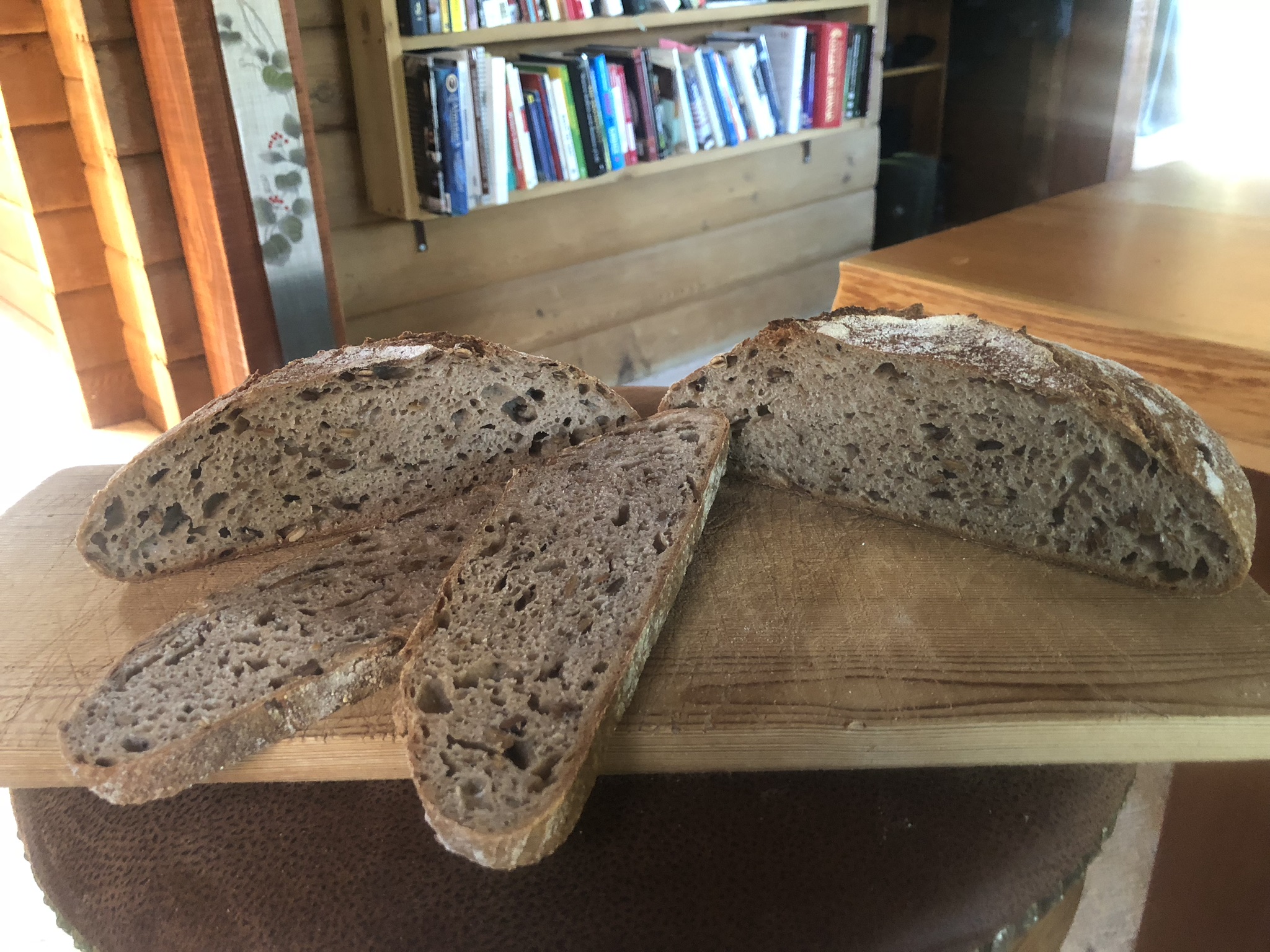Hey guys. Looking for feedback. Some questions:
- At the end of your SLF's would the dough hold any height if shaped into a boule or does it spread? My dough at the end of SLF (before bulk) has lots of extension, some elasticity, doesn't stick much to the wood cutting board, but lacking strength (doesn't hold much shape when rested). I do approx 150 SLF, 5-10m rest, 150 more. Is most of the strength developed later from gas trapped in the gluten network?
- Think I can get anymore rise height in this baked loaf w/o sifting the bran?
- Looking at the crumb, what are your thoughts on the hydration level?
- Think a fridge at 3c vs 4c matters much?
- The loaf was a bit of a spreader, not a lot of spring but the symmetrical crumb and bit of a bloom makes me think it was decently proofed. Agree? Could have spread just from high hydration and impeded gluten network development from the bran?
500g.
14% Rye NMNF levain.
86% Red Fife.
~15% Pumpkin seeds toasted.
~12% Sunflower seeds toasted.
95% hydration.
1.8% salt.
1 hr AL.
150 SLF. 5m rest. 150 SLF.
Bowl folds every 20-40m first 2 hours of Bulk.
2:45 hour bulk at ~21c.
11 hour retard at 4c.
Loaf had expanded a bit during fridge.
Cold baked. 45m DO preheat. 20m 500. 15m 460.
3 hour cool.
I think the crumb is the openness I'm looking for, nicely soft too. There is no gumminess. Crust seems good. Smells wonderfully with the seeds.
What are your thoughts to tweak, vary, improve? Thanks.




I think that's pretty impressive rise for unsifted flour. In my experience 3c vs. 4c does make a difference, because 4c is the threshold where yeast goes dormant.
Thanks for the comment. Anyone else?
I haven't worked with red fife, but have played around a lot with winter white wheat, mostly without sifting. Two things that leap out to me are dough strength and judging final proof.
As to final proofing, if you are too early, you will get some oven spring, but you won't get the full height and open crumb you will get if you put it in the oven at just the right time. If you are too late, the loaf will look fine going in the oven, but will not gain any height, and may even decrease in height while baking. I don't know the time spread between too early and too late, but read somewhere that at room temp, it is only a 15 minute spread ( of course, you can't go by the clock, you have to look at the dough, but the point is there is not a lot of room for error - and I find volume is very hard to estimate in a banneton)
As to dough strength, I am referring to it as a general term - how strong is it at the end of the FP. If it still has some strength, it will be pretty tall going into the oven, and even develop ears as it bakes. If it not strong enough, it will be more dense. I have no idea exactly what factors go into it, but think if it gets overfermented at BF, that makes it tougher to get good high. People with far more knowledge than me can go into the actual processes involve where the dough degrades due to excessive time in BF and FP, or whether there is exhaustion of the food and the yeast have started to die off, all I know is sometimes it comes out great, and sometimes not. The good news is that even when you don't get a very open crumb, my testers all rave about how good it tastes. We are bakers sometimes pay more attention to how it looks and feels, and forget that taste is number 1.
Thanks for the comments.
I'm finding the key for my 100% whole grains, unsifted, hand-milled, rye and red fife, may be to not ferment too much during bulk. I'm just looking for early signs of fermentation, some airy-ness, some jiggle, some expansion, but not letting it go beyond about 15-40% expansion. Then I'm tossing it in the fridge for half the day, taking it out and shaping it cold, retarding the proof for about 11 hours, and baking cold dough in a pre-heated oven and DO.
This loaf was similar but 88% hydration, no seeds. I think I'll go back up to 95% H20 next time. These questions still stand:
Hey Bigblue,
Great looking 100% WW bakes!
I also have a GrainMaker. Have you been able to draw any conclusion about the fineness/coarseness of the milling and how it relates to a more open crumb or more rise? I haven't decided one way or the other yet.
Hey there. It'd be an easy experiment to run, and I should, but I haven't. I usually do it on the finest or one notch below. let me know if you solve the question.
If you want to try to get a more open crumb then use Lucy's bran levain method of sifting put all the hard bits and use them to build the levain at 100% hydration and then retard it for 48 hours after it is built. Autolyse the remaining high extraction flour for 3 hours on the counter or overnight in the fridge. Making sure the dough gets into the oven at 85% proof is another key to max height, bloom and spring in whole grain breads.
Well done and happy baking
Thanks for that, dabrownman. I'll give it a go.